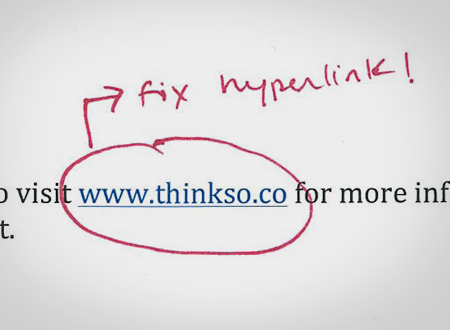Tighten your writin’: fact checking
Tighten Your Writin’ is an ongoing series dedicated to writing tips and best practices.
If you want really professional, buttoned-up content, you not only need to engage your readers with clear, clean prose and pay extra-close attention to sentence structure; you also need to have a rigorous fact-checking process in place. Nothing will derail great content and a solid strategy faster than a misspelled name, erroneous date, or embarrassing typo. Those kinds of careless errors suggest that your company doesn’t pay close enough attention to detail, which tends to make a poor impression on prospective partners, clients, and employees. That’s where fact checking comes in. After all your content is decided upon and every single person has weighed in on the draft you’re going to press with, you should do a round of fact checking. At Thinkso, we use a fact-checking checklist on everything we write. Feel free to download our checklist and use it in your own office.
Fact-Checking Checklist
☐ Check the name of every single proper noun.
- Verify each organization’s name.
- Verify each person’s name and/or title.
- Verify the spelling of any street, county, town, or country names.
- Verify any other proper nouns (laws, holidays, etc.)
- Make sure each name is used consistently throughout the document.
A note about names: When in doubt, defer to the “official” spelling preference — the one that appears on the company website, on formal documents, etc.
☐ Check all phone numbers, addresses, and email addresses.
- Call all phone numbers to make sure they work. If calling is not an option, then search them on the Internet to make sure they’re real and in service.
- Verify all addresses, either with an Internet search or by calling the addressee’s number and verifying that all parts of the address are correct.
- Verify all email addresses by sending a test email. If you can’t do that (or if it wouldn’t be appropriate), verify each email address through the organization’s public-facing website.
☐ Check all links.
- Make sure all hyperlinks work and take you to the correct web page.
☐ Check your dates.
- Verify all dates provided in the document — and make sure they reflect when things really are taking place.
- Make sure to compare all dates against a calendar. Many times something will be listed as “Tuesday, May 8,” and then you’ll find that “Tuesday, May 8” is actually “Thursday, May 8,” or “Tuesday, May 6.” Expect that people will make mistakes.
- Verify that the date of publication is correct. Meetings and pitches are rescheduled all the time, and you don’t want to send out a deck that says “June 21” on June 25.
- Verify the date of any specific laws/guidelines that the text refers to.
☐ Check numbers.
- Make sure all numbers cited are accurate.
- Make sure all numbers that appear in sequence are in the correct sequence.
- Make sure the copy matches the numbers — both in paragraphs and charts and graphs. For example, if the text says that “she had two main points,” and then lists out three points, flag that and bring it back to the writer.
☐ Verify directions and page numbers.
- If something indicates a direction (e.g., “See the chart at left.”), make sure it’s accurate. If not, flag it and return it to the writer.
- If something indicates that text or an image appears on a specific page number (e.g., “See page 7”) or within a certain chart (e.g., “See Figure 2.1”), make sure that it does.
Additional Editorial Best Practices
Ask a colleague to do a “fresh-eye” review. A fresh-eye review is exactly what the name suggests: having someone unfamiliar with the document look at it with fresh eyes. This person should look for:
- Glaring typos
- Words missing
- Anything that jumps off the page as being wildly incorrect
The beauty of both fact checking and fresh-eye reviews is that literally anyone in your company can do them (from your summer interns to your peers) and contribute to the process in a meaningful way. For that very reason, it can be a great (and interesting) way to on-board new staff members. Having them review near-complete content for glaring errors will familiarize them with your tone, style, and suite of materials.
And last but not least: Always, always, always run spell check. The more time you spend on a document, the more likely you are to miss little errors — a word spelled incorrectly, an extra space. That’s why you always, always, always need to run spell check before you send anything on to anyone else in your company. Here’s why: If you take a lax approach to spell check, chances are you take a lax approach with other things as well. And trust me, skipping spell check will come back to haunt you. There will be some day when you go to pick up the latest and greatest version of something you worked on months ago, and you’ll send it to your boss without opening it, and you’ll later find out that there was some horrifying typo in it that made you look sloppy and unprofessional.
